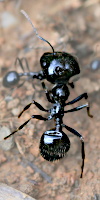
Ants are therefore, not always successfully, called upon for ideas like work, productivity, communication, organisation, and exceed expectations. Finally, ants, like many animals, may also represent nature and the environment.

Ants are therefore, not always successfully, called upon for ideas like work, productivity, communication, organisation, and exceed expectations. Finally, ants, like many animals, may also represent nature and the environment.
Do you want to know what your future pension will look like ?You the reader are working hard, just like the ant, but contrary to the ant, you must not rely on a fortune teller to know if retirement will bring misery or pleasure. A special website is announced where the reader may get an estimate based on his own working history so far. The poor ant must do with the Gipsy Grandma which is a small coin operated fortune teller with sophisticated movements, like nods, turns of the head, and hands picking cards. Sophisticated for its time at least: grandma came out in 1957 !
together -> sorting well -> better recycling. I do not understand the connection with ants, or their labor. Ants are in the business of recycling, but the image is certainly not the best illustration. The advert is about recycling of disposed materials and what the ants are carrying are green leaves. These are taken from plants where the leaves are still very much in use. In the context of recycling, brown, dry leaves would have been a better choice.
Given the amount of work in progress, I find it remarkable that none of the leaves still on the branch shows any cutout. Also, why are the ants climbing upwards with their catch ? They should carry their load down to the nest, where the fungal gardens are.
I am not sure how to read the announcement. The ants are likely choosen because of the providential ant of Aesopus again. But does the text means that I myself —supposedly the banker— will have to do all the work ? Instead of my money and the savingsbank ? If that is the case then it is more profitable to entrust my money elsewhere. In that same year, 2004, another company also in the money business and also referring to Aesopus, offers much better conditions: see Rabbits & Hares.
And so are we, declare an airport (8), a family car (9, ‡), a designer of ships (10), a digital press (11), and computers (13). In all these advertisements contrast is used between the tiny creature and the impressive performance. It is a common approach when the actors are very small or very big animals (see also the chapters about Mice, and Elephants).
The network switch of № 14 rightly states: Power means nothing without control
. The ant would get nowhere
with its load if it couldn't control its own course. The approach is different from the previous advertisements. Not the size of the
load is important, but the fact that the animal manages to keep the load under control.
and made improvements. There is a touch of this theme in advertisement № 9 for the family car (‡) where we are asked
Do you know many ants with athermanous ¶, tinted windows?
Other advertisements, like the №s 12, 15, and 17 go the full way of telling us what they did learn from the Ant but none of them are even slightly convincing.
Some workflows in nature are perfectly organised(15). And then they continue with
But for the production of printed materials …. There is of course their software solution which
integrates every step of the production process and at the same time sends information to management. They never refer to the ants of the image —leafcutters, yes— and what other connection there may be is not clear as indeed there is no dedicated caste of ants doing the management of the flow of green leafs.
Nature evolves smoothly and efficiently. Just like us with our flexible and reliable storage system. Nature does not evolve smoothly and efficiently, just as she does not evolve in circles (see Smaller Cetaceans). The caption
Who is smart can also be strongand the choice of ants is difficult to understand. It clearly is an allusion to the proverb
those who are not strong must be smart, but what about the ants. Are they smart? Strong perhaps because of their number? But what is the relationship with storage discs in different sizes?
Interesting: one of the strong points of the system is that … you can send disks by express mail: the ideal alternative to modems and a saving of your valuable computer time.
It was a different time, back then in the year 1990. Nostalgia.
Access Anytime Anywhere
‡ The text is hilarious and was probably written while under influence of hallucinogenics.
Translated from Dutch: First there was the ant. Lively, always on the go and working like no other. And then Volkswagen created the Polo. Nimble, manoeuvrable and reliable. It soon became clear that he could be compared in many ways with his neighbor, the ant.
… Even the ant wonders how he
[the Polo] manages to do it with so little [fuel].
… and so on.
¶ athermanous = capable of stopping radiant heat or infrared radiation.